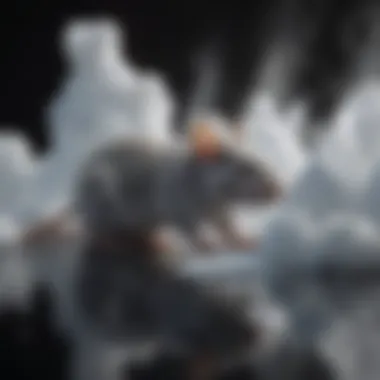Optimizing Rat Elimination: The Power of Dry Ice


Preventive Pest Control Strategies
House Exterior Protection
Accurate tips for sealing cracks: Start by examining the exterior of your house meticulously, looking for even the tiniest cracks that could serve as entry points for unwanted pests. Seal these crevices using a high-quality, waterproof sealant to prevent pests from making their way indoors. Remember, pests can squeeze through incredibly small openings, so attention to detail is key. Once you have sealed all visible cracks, consider applying a protective barrier around the perimeter of your home to deter pests further
Clearing debris advice: Debris in your yard provides hiding spots and nesting opportunities for pests such as rats. Make sure to regularly remove any piles of wood, leaves, or other organic matter lying around your property. Trim overgrown bushes and trees, as branches touching your house can act as bridges for pests to access your home
Keeping pests at bay: Preventing pests from entering your house starts with a thorough inspection of all possible entry points. Install door sweeps on exterior doors to create a tight seal, repairing or replacing damaged screens on windows, and ensuring that gaps around pipes and cables entering your home are adequately sealed. Remember, pests are opportunistic and will exploit any opening to gain access to your living spaces
Yard Maintenance
Essential yard care routines: Maintaining a neat and tidy yard is essential to reducing the risk of pest infestations. Regularly mow your lawn, rake up fallen leaves, and trim bushes to eliminate potential hiding spots for pests. Keep your yard free of standing water, which attracts various pests, and consider using mulch made of pest-resistant materials
Methods for a pest-free yard: Implementing integrated pest management techniques can help keep your yard free from pests. This approach combines biological, cultural, and physical methods to manage pests in an environmentally responsible manner. Planting pest-resistant species, using barriers to keep pests out, and practicing good watering and fertilizing habits can all contribute to a pest-free yard
Identifying Pest Risk Areas
Inspection of moisture-prone areas: Damp conditions can attract pests like rats, termites, and cockroaches. Inspect areas prone to moisture accumulation such as basements and crawl spaces for signs of water damage. Address any leaks or condensation issues promptly to prevent infestations
Guide for checking cracks and crevices: Inspect the exterior of your house for any cracks or gaps that pests could use to infiltrate your home. Sealing these entry points with caulk or an appropriate sealant can help prevent pests from gaining access. Consider using weather stripping around doors and windows to create a tighter seal
Assessing greenery for pest risks: The vegetation around your home can either attract or repel pests. Overgrown trees and shrubs provide hiding spots for pests, so proper trimming and maintenance are key. Remove any dead or decaying plant matter and keep branches away from your home to prevent pests from accessing your roof or walls
Identifying additional risk areas: Pests can find their way into your home through various entry points. Pay attention to areas such as vents, chimneys, and utility openings, which may provide easy access for pests. Seal off these potential entryways to fortify your home against infestations
Effective Pest Control Methods
Natural repellents for pest control: Harness the power of natural solutions to deter pests from entering your home. Essential oils like peppermint, citronella, and lavender can be used as natural repellents to keep pests at bay. Planting mint can also act as a natural deterrent for rodents like mice
Chemical sprays for pest control: While chemical sprays should be used with caution, they can be effective in eradicating pests when applied correctly. Look for environmentally friendly pest control sprays that are safe for indoor use. Follow the manufacturer's instructions carefully and keep children and pets away from treated areas
Utilizing pest traps: Setting up traps can help you monitor and control pest populations effectively. Choose traps specific to the type of pest you are dealing with, whether it's rats, ants, or flies. Place traps in areas where pests are likely to travel, such as along walls or near entry points
Implementing biological control methods: Introducing natural predators of pests can be a sustainable way to manage pest populations. Consider attracting birds that feed on insects or deploying beneficial insects like ladybugs to control aphids in your garden. These biological control methods offer a natural solution to pest problems
Exploring other control methods: From ultrasonic pest repellent devices to electromagnetic pest control, there are innovative methods available to combat pests. Do thorough research to determine which method suits your needs and preferences best. Always follow instructions carefully to maximize the effectiveness of these techniques
Pest Species Identification
Spotting common home insects: Understanding the types of insects that commonly infiltrate homes can help you take targeted action against them. Ants, cockroaches, and spiders are frequent intruders in households and can be managed with specific pest control methods. Identify the signs of these insects to address infestations early


Recognizing rodents: Rodents like mice and rats are not only nuisances but also vectors of disease. Look for droppings, gnaw marks, or chewed packaging to determine if you have a rodent infestation. Use traps or deterrents to keep these pests at bay and seal off entry points to prevent their return
Dealing with bird-related issues: Birds can create problems for homeowners through nesting activities, droppings, and noise. Addressing bird-related issues may involve installing deterrents, enhancing exclusion methods, or encouraging birds to relocate. Research local ordinances and regulations before taking any actions against nuisance bird species
Managing wildlife encounters: In rural or semi-urban areas, encounters with wildlife like raccoons, squirrels, or deer are not uncommon. Understanding the behavior of these animals and implementing humane control measures can help mitigate conflicts. Contact local wildlife authorities for guidance on handling wildlife encounters
Identification of lesser-known pests: Some pests may not be as familiar as rats or ants but can still pose a threat to your home and health. Educate yourself on lesser-known pests in your region and be vigilant for signs of infestations. Consult with pest control professionals to correctly identify and address these less common pests
DIY Pest Control Techniques
Crafting homemade pest control solutions: Create your own eco-friendly pest control remedies using common household ingredients. Mixtures of vinegar, baking soda, and essential oils can serve as effective pest deterrents without the need for harsh chemicals. Experiment with different DIY solutions to find what works best for your pest problems
Using essential oils for pest control: Essential oils like eucalyptus, peppermint, and tea tree oil have natural insect-repelling properties. Create custom oil blends to spray around your home or use oil-infused cotton balls to deter pests from specific areas. Essential oils not only fend off pests but also leave your home smelling fresh and pleasant
Implementing pest traps and barriers: Set up physical barriers like door sweeps and window screens to keep pests out of your home. Place traps strategically in areas where pests are likely to travel, such as along baseboards or in pantries. Regularly check and empty traps to maintain their effectiveness in controlling pest populations
Exploring reputable pest control brands: Research trusted pest control brands that offer safe and reliable products for home use. Look for brands that prioritize environmental sustainability and human safety in their formulations. Invest in quality pest control solutions to protect your home and family from unwanted intruders
Discovering unique DIY techniques: Get creative with your pest control approaches by exploring unconventional methods. From using garlic as a natural insect repellent to employing diatomaceous earth for crawling insect control, there are a plethora of DIY techniques to try. Experiment with different strategies to find the most effective ones for your unique pest challenges
Introduction
The utilization of dry ice for rat elimination is a powerful method that warrants exploration. This article aims to delve into the intricacies of employing dry ice to eradicate rat infestations effectively. By understanding the nuances of this technique, readers can grasp its significance in the realm of pest control and property preservation.
Understanding the Use of Dry Ice for Rat Control
Properties of Dry Ice
Dry ice, a solid form of carbon dioxide, plays a crucial role in pest control due to its unique properties. One key characteristic of dry ice is its sublimation process, transitioning directly from a solid to a gas without leaving any residue. This quality makes dry ice an environmentally friendly and residue-free option for rat elimination, unlike traditional chemical methods.
Advantages of Using Dry Ice for Pest Control
The advantages of utilizing dry ice for pest control extend beyond its residue-free nature. Dry ice effectively targets pests like rats through the sublimation process, displacing oxygen and suffocating rodents in their burrows. This method is non-toxic and poses fewer risks to humans and pets compared to chemical treatments, making it a safer and efficient choice for pest control endeavors.
Significance of Rat Elimination
Health Risks Posed by Rat Infestations
Rat infestations are not only a nuisance but also pose significant health risks to inhabitants. Rats are carriers of various diseases such as leptospirosis and hantavirus, endangering the well-being of individuals within the infested property. Understanding these health risks underscores the importance of swift and effective rat elimination methods.
Property Damage Caused by Rats
In addition to health risks, rats can cause extensive damage to properties. Their constant gnawing behavior can lead to structural issues in buildings, chewed wires, and contamination of stored food items. The financial implications of repairing rat-induced damage can be substantial, emphasizing the significance of rat elimination for property maintenance and preservation.


Purpose of the Article
Informing Readers About Effective Rat Eradication Methods
The primary goal of this article is to inform readers about the various methods available for rat eradication, with a focus on the efficacy of using dry ice. By providing insights into these methods, readers can make informed decisions on the most suitable approach for their specific infestation scenarios.
Highlighting the Efficiency of Dry Ice
Central to this article is the emphasis on the efficiency of dry ice as a rat elimination tool. Highlighting the effectiveness of dry ice in disrupting rat populations and minimizing associated risks underscores its value in the realm of pest control. Readers will gain a deeper understanding of why dry ice stands out as a reliable and innovative solution for effective rat elimination.
Rat Control with Dry Ice
In this section, we delve into the critical topic of Rat Control with Dry Ice. The use of dry ice for rat elimination presents a revolutionary approach to pest management. Unlike traditional methods, dry ice offers a non-toxic and eco-friendly solution that effectively targets rat populations without posing harm to the environment or inhabitants. This method stands out for its ability to provide a clean and efficient eradication process, making it a preferred choice for those seeking sustainable pest control options. With its unique properties, dry ice becomes a powerful tool in combating rat infestations.
Mechanism of Action
Asphyxiation of Rats
The asphyxiation of rats through the use of dry ice is a crucial aspect of the eradication process. By releasing carbon dioxide in solid form, dry ice displaces oxygen in the surrounding environment, leading to oxygen deprivation for the rats. This method effectively targets the respiratory system of rats, causing them to suffocate without the use of harmful chemicals. The asphyxiation process ensures a humane and silent approach to rat control, making it a preferred choice for those concerned about animal welfare.
Effective Disruption of Rat Population
Another key element in Rat Control with Dry Ice is the effective disruption of the rat population. By strategically placing dry ice in rat-infested areas, the sudden release of carbon dioxide creates a hostile environment for rats to thrive. This disruption not only eliminates existing rats but also deters new ones from establishing colonies. The rapid and wide-reaching impact of this method ensures a comprehensive approach to rat population control, making it a highly efficient and reliable solution.
Determining the Quantity of Dry Ice Needed
Factors Influencing Quantity Calculation
When calculating the quantity of dry ice needed for rat elimination, several factors come into play. The size of the infested area, the severity of the rat population, and environmental conditions all influence the amount of dry ice required. Understanding these factors is essential in determining an effective eradication strategy. By carefully assessing the specific conditions of the infested site, optimal quantities of dry ice can be strategically deployed for maximum impact.
Estimating the Rat Population Size
Accurately estimating the size of the rat population is a critical step in planning the eradication process. Through observation, tracking of rat activity, and data analysis, the approximate number of rats present can be determined. This estimation helps in calculating the precise amount of dry ice needed to target the entire population effectively. By considering factors such as breeding patterns and nesting sites, a more accurate assessment of the rat population size can be achieved.
Safety Precautions
Handling Dry Ice Safely
Ensuring the safe handling of dry ice is paramount in the rat elimination process. Proper protective gear, such as gloves and goggles, should be worn when handling dry ice to prevent frostbite and skin irritation. Additionally, adequate ventilation in the treatment area is essential to minimize the risk of carbon dioxide buildup. By following strict safety protocols, the risk of accidents or mishaps associated with dry ice usage can be significantly reduced.
Preventing Exposure to Carbon Dioxide
Preventing exposure to carbon dioxide is crucial to the safety of individuals involved in rat eradication efforts. Carbon dioxide, while non-toxic in small quantities, can displace oxygen in the air, leading to asphyxiation in enclosed spaces. Proper ventilation and monitoring of carbon dioxide levels are essential to prevent inadvertent exposure. By prioritizing safety measures and awareness, the risks associated with carbon dioxide exposure can be effectively mitigated.


Application of Dry Ice for Rat Elimination
In this crucial section, we will delve deep into the application of dry ice for effective rat eradication. The utilization of dry ice presents a cutting-edge method in pest control, offering a potent solution to address challenging rat infestations. By strategically deploying dry ice, householders and homeowners can target these pesky rodents with precision, ensuring a comprehensive approach to rat elimination. Notably, the method underscores the importance of employing environmentally friendly pest control measures, minimizing adverse impacts on the ecosystem. This section will highlight the specific elements, benefits, and considerations essential for mastering the application of dry ice in rat eradication.
Dos and Don'ts
Proper Placement of Dry Ice
When it comes to the proper placement of dry ice for rat elimination, precision is paramount. Selecting strategic locations where rat activity is high enhances the effectiveness of the treatment, maximizing the eradication results. Proper placement involves identifying rat burrows, pathways, and feeding areas to ensure direct exposure to the carbon dioxide released by the dry ice. This targeted approach increases the likelihood of rats coming into contact with the substance, accelerating the extermination process. Homeowners and housewives can benefit significantly from mastering the art of proper placement, as it can boost the overall efficiency of the eradication campaign.
Avoidance of Common Mistakes
Amid the process of rat elimination using dry ice, steering clear of common mistakes is crucial for success. One prevalent error to avoid is using insufficient quantities of dry ice, which may lead to incomplete extermination and potential rat resurgence. Additionally, overlooking critical safety measures such as wearing protective gear when handling dry ice can pose risks to human health. Understanding these common mistakes and actively avoiding them is vital in ensuring a smooth and effective rat eradication process. By emphasizing the importance of vigilance and attention to detail, household owners can avert setbacks and achieve optimal results in rat elimination.
Monitoring and Evaluation
Assessing Efficacy of Dry Ice Treatment
The evaluation of dry ice treatment efficacy serves as a pivotal aspect of the rat elimination process. Monitoring the impact of the treatment on rat populations enables homeowners to gauge the success of the eradication campaign. By observing reductions in rat activity and population size, individuals can ascertain the effectiveness of the dry ice method in eradicating the infestation. This thorough assessment empowers users to make informed decisions regarding the continuation or modification of the eradication strategy, ensuring efficient and targeted rat elimination.
Follow-up Procedures for Rat Elimination
Following the initial dry ice treatment, implementing comprehensive follow-up procedures is essential for sustained rat elimination success. Conducting regular inspections to monitor rat activity post-treatment allows homeowners to address any potential resurgence promptly. Additionally, tasks such as sealing entry points and eliminating attractants further bolster the efficacy of rat elimination efforts. By integrating meticulous follow-up procedures into their pest control regimen, individuals can fortify the results of the initial dry ice treatment and maintain a rat-free environment effectively.
Alternative Approaches
Comparative Analysis of Pest Control Methods
In evaluating alternative pest control methods, conducting a comparative analysis offers valuable insights into the strengths and weaknesses of each approach. Contrasting the efficiency, safety, and environmental impact of diverse pest control strategies elucidates the advantages of utilizing dry ice for rat elimination. This analysis equips householders with the knowledge needed to make informed decisions regarding the most suitable method for their specific infestation scenario. By harnessing the information derived from a comparative analysis, individuals can adopt the most effective and sustainable pest control approach tailored to their unique requirements.
Combination Strategies for Enhanced Results
For homeowners seeking enhanced results in rat elimination, embracing combination strategies proves to be a game-changer. By synergizing the benefits of dry ice treatment with supplementary pest control measures, individuals can create a robust and comprehensive eradication plan. Incorporating methods such as habitat modification, exclusion techniques, and sanitation practices alongside dry ice treatment amplifies the impact of pest control efforts, ensuring a more thorough and enduring solution to rat infestations. This strategic integration of multiple approaches holds the key to achieving unparalleled results in rat elimination, elevating the efficacy and sustainability of pest control endeavors.
Conclusion
Furthermore, the focus on safety measures such as proper handling of dry ice and avoiding carbon dioxide exposure is paramount. Safety should always be a top priority when dealing with pest control methods like dry ice, as mishandling can result in adverse effects. This article aims to equip readers with the knowledge and insights needed to undertake rat elimination procedures safely and efficiently, emphasizing the critical role of adherence to safety protocols throughout the process.
Key Takeaways
Efficiency of Dry Ice for Rat Extermination
Exploring the efficiency of dry ice for rat extermination reveals a potent method that offers a non-toxic and environmentally friendly approach to pest control. The unique mechanism of action, which involves asphyxiating rats by displacing oxygen with carbon dioxide, ensures a swift and effective elimination process. This high efficacy makes dry ice a popular choice for rat extermination among environmentally conscious individuals seeking a humane yet efficient solution. While the absence of toxic substances enhances safety for humans and pets, the rapid and thorough eradication of rat populations stands out as a key advantage of employing dry ice for pest control.
Importance of Proper Quantity Calculation
The importance of accurately calculating the quantity of dry ice required for rat elimination cannot be overstated. Proper quantity calculation is a fundamental aspect of ensuring the success of the eradication process. Factors such as the size of the rat population and environmental conditions play a crucial role in determining the amount of dry ice needed. By calculating the quantity diligently, individuals can avoid under-dosing, which may lead to incomplete extermination, or overdosing, which can pose risks to human health.
Moreover, precise quantity calculation optimizes the cost-efficiency of the treatment by minimizing wastage and unnecessary expenditure. By focusing on the right quantity of dry ice needed for rat extermination, individuals can achieve optimal results while prioritizing safety and environmental sustainability.



